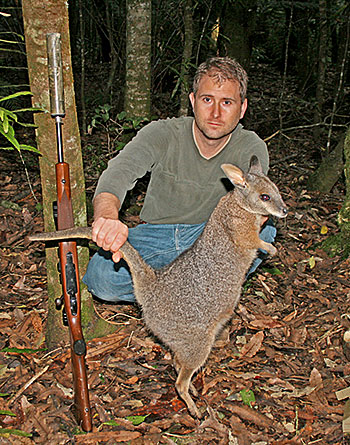 Dylan Saunders never had any use for an AR-15. A shooter, hunter, and gun collector from childhood, he felt hunting rifles should be made of blued steel and walnut, and have a lever beneath the action. Military-style rifles should have Mauser or Springfield in the name and wood in the stock. He joined the Army and was underwhelmed by the worn-out M16 he shot in basic training, and was not impressed by the M16s and M4s he was issued later. He shot them well, and was comfortable with using them, but it was not until much later that he came to two realizations. The first was that the ergonomics of the M4 it an ideal weapon, and the second was that the accuracy potential of the AR platform was so amazing. After 26 years of shooting and 12 years of shooting M16s and M4s in the military, he bought his first AR.
Dylan Saunders never had any use for an AR-15. A shooter, hunter, and gun collector from childhood, he felt hunting rifles should be made of blued steel and walnut, and have a lever beneath the action. Military-style rifles should have Mauser or Springfield in the name and wood in the stock. He joined the Army and was underwhelmed by the worn-out M16 he shot in basic training, and was not impressed by the M16s and M4s he was issued later. He shot them well, and was comfortable with using them, but it was not until much later that he came to two realizations. The first was that the ergonomics of the M4 it an ideal weapon, and the second was that the accuracy potential of the AR platform was so amazing. After 26 years of shooting and 12 years of shooting M16s and M4s in the military, he bought his first AR.
Dylan grew up on a homestead in the bush in Alaska. Living in a village with a population that ranged from about 50 in the winter to about 100 in the summer, he grew up without electricity. His family ate what could be caught, shot, or grown. Mail came in once a week on a float plane, and only non-perishable bulk food like powdered milk and flour could be ordered in.
Hunting in this frontier lifestyle was a serious thing. Hunting was primarily about survival. Sport was secondary and trophies were rarely a consideration. With a limit of 5 deer per family member per year, a rifle like his father’s M1A, capable of dropping three or four deer in a herd before the rest could run, or hitting a target beyond the range most hunters are comfortable to shoot,
could mean the difference between having meat or going hungry. This lifestyle also led to a greater respect for the game itself and a concern by all residents to protect and manage the game populations.
Dylan lived and worked in several states and in New Zealand as a graphic artist. He is a combat veteran and served as a company-level sniper in Iraq, where he was injured, causing him to leave the military. He has been an explosives engineer since college, which has given him the opportunity to work and hunt in remote locations all around the state of Alaska.
In addition to working as an explosives engineer, he has worked in the firearms industry since 2006 handling marketing, in-house design, product testing, writing, and photography for a weapon accessory company, coating firearms, distributing Front Line holsters, and instructing.
Read Dylan’s Wilderness Tactical Hunter entries >>>>

